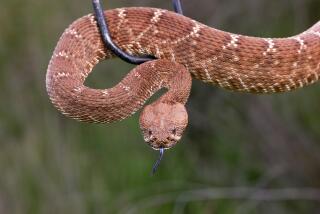Heads Shaking Over Pro-Rattler PR
- Share via
CARLYLE, Ill. — As poisonous rattlesnakes go, the eastern massasauga is a wimp. It’s shy and on the small side. Curled up in the prickly prairie grass, it looks downright docile.
Yet it has managed to touch off a doozy of a skirmish here in southwestern Illinois farm country.
The massasauga is endangered across most of its native Midwest habitat. And its last stronghold in Illinois is the overgrown wetland in and around this town of 2,500. So state and federal agencies have launched an effort to protect the species by counting them, studying their habits--and trying to persuade a skeptical public that massasaugas are worth saving.
It’s this last campaign that has some folks in Carlyle sputtering. For to teach the public that the massasauga deserves protection, environmentalists must first let everyone know the snakes are here. That means school programs, ranger talks, media tours, brochures--even a dozen “Please brake for snakes” road signs.
And that’s a lot more publicity for the venomous viper than some here want, because Carlyle’s big industry is tourism. There’s a gorgeous man-made lake in town and two state parks nearby. Fishermen, sailors, hikers, campers and hunters come from all over. Carlyle’s economy depends on them.
So emphasizing the poisonous snake population does not strike critics as the brightest idea.
“We also have horseflies and ticks around the lake. But we don’t market it by saying: ‘Come here to Carlyle and get bitten by a horsefly,’ ” complained Ric Golding, who runs a tour boat and marina.
“They don’t even have a sign welcoming anybody to the lake, and yet they have these snake signs out,” added Warren Dempsey, editor of the local paper. “If they just forgot about this whole thing . . . the snakes would thrive [in anonymity], like they’ve thrived here for hundreds of years. And everybody would be happy.”
But environmentalists say the snakes are not thriving.
They have counted more than 200 massasaugas around the lake, on property managed by the Army Corps of Engineers. That is not a complete tally; the snakes are notoriously hard to find.
Still, it seems clear that there are considerably fewer massasaugas now than there were a century ago, when farmers would report slicing up several dozen of the tan-and-brown rattlers each day as they cleared their fields. Back then, there were even bounties on the snakes: Officials would pay $5 a head for dead rattlers. And hunters were all too happy to cash in.
“They would kill them just to get rid of them,” said Don Shepard, a snake ecologist for the Illinois Department of Natural Resources. “It was outright persecution.”
Man is still the biggest threat to the massasauga, mostly by accident: The endangered snakes routinely get run over by cars or diced up by lawn mowers.
Their habitat also is disappearing, with the rough wetland marshes they prefer becoming parking lots or cornfields.
That’s why Shepard and his colleagues are pushing the education campaign along with their conservation efforts. They would like residents to think twice before dousing massasauga habitat with pesticide, to curtail mowing during the snakes’ active period, to consider turning some cultivated fields back into swampy prairie.
To do that, however, they must get the snake a bit of positive PR.
They’re spreading the word that the massasauga won’t bite unless it feels threatened. If it does strike, its venom can cause dizziness, nausea, intense stinging and swelling--but it is rarely fatal. And although snakes have a long-standing bad reputation, they do hold down the rodent population.
“You’ll probably never get people to warm up to snakes like you would an animal that’s cute and fuzzy,” Shepard acknowledged.
“But if they’d just respect them,” added Joe Smothers, a natural resource specialist for the Corps. “It’s all part of the experience when you come out to Carlyle. You see butterflies, you see deer and maybe you see snakes.”
Believe it or not, that’s been an effective sales pitch a bit farther north, at Killbear Provincial Park in Ontario, Canada. Biologists there have been monitoring the massasauga since 1995; their education campaign has proved such a hit that cruise ships stop by for ranger talks on the snake, and tourists have been known to demand a refund if they fail to spot a rattler. “Please brake for snakes” T-shirts, coffee mugs and bumper stickers brought in $13,000 for massasauga research at the park last year.
“I’m not going to pretend that if we didn’t have the rattlesnake here in the park the regional economy would collapse,” biologist Chris Parent said. “But it’s an interesting addition for people. A niche market.”
Civic leaders here are not convinced Carlyle is ready to fill that niche.
They worry that enhanced protections for the snakes will mean red tape for developers seeking to build in potential massasauga habitat. A $10-million lakeside resort was delayed three years because of snake concerns--and that was before the new preservation plan took effect. More recently, the state relocated 10 cabins it had planned as a waterfront tourist draw. To avoid trampling massasauga habitat, the cabins have been moved back “into the woods, with all the mosquitoes,” Dempsey grumbled.
At City Hall, meanwhile, administrators have been fielding the occasional call or e-mail from out-of-towners skittish about visiting a snake pit. The truth is, locals who have lived here for decades rarely, if ever, have run across massasaugas. And there have been no snake bites at the lake in its 33 years of operation. Yet tourists hear “rattler” and get leery.
“I’m sure it’s hurt us some,” City Administrator Van Johnson said.
Corps officials pointed out that tourism at Lake Carlyle has jumped this year: Day use of the lake has spiked 23% and revenue from campground fees is up 33%. Over Labor Day weekend, 100,000 tourists crowded the lake.
As they kicked back on the beach one recent afternoon, visitor after visitor explained why. The “brake for snakes” signs would not scare them off, they said, any more than the notice on the beach: “No lifeguard. Swim at your own risk. Drownings at this lake to date: 69.”
They came to Carlyle because they wanted to get away, to get back to nature. So they would take what nature had to offer. Pit vipers included.
“That’s why the good Lord gave them a rattle,” retiree Wanda Wilke said with a chuckle. “To warn you to get away.”
More to Read
Sign up for Essential California
The most important California stories and recommendations in your inbox every morning.
You may occasionally receive promotional content from the Los Angeles Times.










